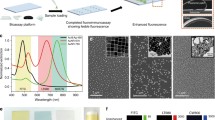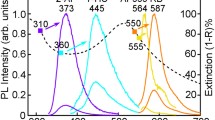Abstract
A novel gap-plasmon-tunable Ag bilayer nanoparticle film for immunoassays is demonstrated. Different from a traditional Ag monolayer nanoparticle film, a desired number of polyelectrolyte (PEL) layers are deposited on the nanoparticles before the self-assembly of a second Ag nanoparticle layer. Interestingly, by controlling the number of the PEL interlayers, the gap plasmon between the two Ag nanoparticle layers can be tuned across the visible spectral range. The ability of the presented Ag bilayer nanoparticle films in fluorescence enhancement has been examined experimentally. A maximal enhancement of around 15.4 fold was achieved when 7 layers of polyelectrolyte were used. When this optimal Ag bilayer nanoparticle film was applied to fluorescence immunoassay, a performance with approximately 3.3-fold enhancement was obtained compared with that performed on a traditional glass substrate. The experimental results suggest that the presented gap-plasmon tunable Ag bilayer nanoparticle films have great potential in fluorescence-based immunoassays. The method of the bilayer-film construction presented here also provides new insights into the rational design of the plasmonic substrates.






Similar content being viewed by others
References
Gosling JP (1990) A decade of development in immunoassay methodology. Clin Chem 36(8):1408–1427
Aslan K, Gryczynski I, Malicka J, Matveeva E, Lakowicz JR, Geddes CD (2005) Metal-enhanced fluorescence: an emerging tool in biotechnology. Curr Opin Biotechnol 16(1):55–62. doi:10.1016/j.copbio.2005.01.001
Li RQ, Xu SH, Wang CL, Shao HB, Xu QY, Cui YP (2010) Metal-enhanced fluorescence of CdTe nanocrystals in aqueous solution. Chemphyschem 11(12):2582–2588. doi:10.1002/cphc.201000239
Zhang RH, Wang ZY, Song CY, Yang J, Li J, Sadaf A, Cui YP (2011) Surface-enhanced fluorescence from fluorophore-assembled monolayers by using Ag@SiO2 nanoparticles. Chemphyschem 12(5):992–998. doi:10.1002/cphc.201000849
Kulakovich O, Strekal N, Yaroshevich A, Maskevich S, Gaponenko S, Nabiev I, Woggon U, Artemyev M (2002) Enhanced luminescence of CdSe quantum dots on gold colloids. Nano Lett 2(12):1449–1452. doi:10.1021/nl025819k
Malicka J, Gryczynski I, Gryczynski Z, Lakowicz JR (2003) Effects of fluorophore-to-silver distance on the emission of cyanine-dye-labeled oligonucleotides. Anal Biochem 315(1):57–66. doi:10.1016/s0003-2697(02)00702-9
Anger P, Bharadwaj P, Novotny L (2006) Enhancement and quenching of single-molecule fluorescence. Phys Rev Lett 96(11). doi:10.1103/PhysRevLett.96.113002
Wang YS, Liu B, Mikhailovsky A, Bazan GC (2010) Conjugated polyelectrolyte-metal nanoparticle platforms for optically amplified DNA detection. Adv Mater 22(5):656–659. doi:10.1002/adma.200902675
Lakowicz JR, Shen YB, D'Auria S, Malicka J, Fang JY, Gryczynski Z, Gryczynski I (2002) Radiative decay engineering 2. Effects of silver island films on fluorescence intensity, lifetimes, and resonance energy transfer. Anal Biochem 301(2):261–277. doi:10.1006/abio.2001.5503
Gersten J, Nitzan A (1981) Spectroscopic properties of molecules interacting with small dielectric particles. J Chem Phys 75(3):1139–1152. doi:10.1063/1.442161
Ruppin R (1982) Decay of an excited molecule near a small metal sphere. J Chem Phys 76(4):1681–1684. doi:10.1063/1.443196
Das PC, Puri A (2002) Energy flow and fluorescence near a small metal particle. Phys Rev B 65(15). doi:10.1103/PhysRevB.65.155416
Sokolov K, Chumanov G, Cotton TM (1998) Enhancement of molecular fluorescence near the surface of colloidal metal films. Anal Chem 70(18):3898–3905. doi:10.1021/ac9712310
Hayakawa T, Selvan ST, Nogami M (1999) Field enhancement effect of small Ag particles on the fluorescence from Eu3+-doped SiO2 glass. Appl Phys Lett 74(11):1513–1515. doi:10.1063/1.123600
Selvan ST, Hayakawa T, Nogami M (1999) Remarkable influence of silver islands on the enhancement of fluorescence from Eu3+ ion-doped silica gels. J Phys Chem B 103(34):7064–7067. doi:10.1021/jp9902755
Lakowicz JR (2005) Radiative decay engineering 5: metal-enhanced fluorescence and plasmon emission. Anal Biochem 337(2):171–194. doi:10.1016/j.ab.2004.11.026
Matveeva EG, Gryczynski Z, Lakowicz JR (2005) Myoglobin immunoassay based on metal particle-enhanced fluorescence. J Immunol Methods 302(1–2):26–35. doi:10.1016/j.jim.2005.04.020
Zhang J, Matveeva E, Gryczynski I, Leonenko Z, Lakowicz JR (2005) Metal-enhanced fluoroimmunoassay on a silver film by vapor deposition. J Phys Chem B 109(16):7969–7975. doi:10.1021/jp0456842
Shtoyko T, Matveeva EG, Chang IF, Gryczynski Z, Goldys E, Gryczynski I (2008) Enhanced fluorescent immunoassays on silver fractal-like structures. Anal Chem 80(6):1962–1966. doi:10.1021/ac7019915
Barnett A, Matveeva EG, Gryczynski I, Gryczynski Z, Goldys EM (2007) Coupled plasmon effects for the enhancement of fluorescent immunoassays. Physica B 394(2):297–300. doi:10.1016/j.physb.2006.12.085
Nooney R, Clifford A, LeGuevel X, Stranik O, McDonagh C, MacCraith BD (2010) Enhancing the analytical performance of immunoassays that employ metal-enhanced fluorescence. Anal Bioanal Chem 396(3):1127–1134. doi:10.1007/s00216-009-3357-9
Tam F, Goodrich GP, Johnson BR, Halas NJ (2007) Plasmonic enhancement of molecular fluorescence. Nano Lett 7(2):496–501. doi:10.1021/nl062901x
Chen Y, Munechika K, Ginger DS (2007) Dependence of fluorescence intensity on the spectral overlap between fluorophores and plasmon resonant single silver nanoparticles. Nano Lett 7(3):690–696. doi:10.1021/nl062795z
Bardhan R, Grady NK, Cole JR, Joshi A, Halas NJ (2009) Fluorescence enhancement by Au nanostructures: nanoshells and nanorods. ACS Nano 3(3):744–752. doi:10.1021/nn900001q
Ishida A, Kumagai K (2009) Fluorescence enhancement due to gap mode of gold colloids immobilized on a hydrophilic amino-terminated glass substrate. Chem Lett 38(2):144–145. doi:10.1246/cl.2009.144
Lu Y, Liu GL, Lee LP (2005) High-density silver nanoparticle film with temperature-controllable interparticle spacing for a tunable surface enhanced Raman scattering substrate. Nano Lett 5(1):5–9. doi:10.1021/nl048965u
Cunningham A, Muhlig S, Rockstuhl C, Burgi T (2011) Coupling of Plasmon Resonances in Tunable Layered Arrays of Gold Nanoparticles. J Phys Chem C 115(18):8955–8960. doi:10.1021/jp2011364
Lee PC, Meisel D (1982) Adsorption and surface-enhanced raman of dyes on silver and gold sols. J Phys Chem 86(17):3391–3395. doi:10.1021/j100214a025
Nordlander P, Oubre C, Prodan E, Li K, Stockman MI (2004) Plasmon hybridization in nanoparticle dimers. Nano Lett 4(5):899–903. doi:10.1021/nl049681c
Kuhn S, Hakanson U, Rogobete L, Sandoghdar V (2006) Enhancement of single-molecule fluorescence using a gold nanoparticle as an optical nanoantenna. Phys Rev Lett 97(1). doi:10.1103/PhysRevLett.97.017402
Viste P, Plain J, Jaffiol R, Vial A, Adam PM, Royer P (2010) Enhancement and quenching regimes in metal–semiconductor hybrid optical nanosources. ACS Nano 4(2):759–764. doi:10.1021/nn901294d
Ming T, Zhao L, Yang Z, Chen HJ, Sun LD, Wang JF, Yan CH (2009) Strong polarization dependence of plasmon-enhanced fluorescence on single gold nanorods. Nano Lett 9(11):3896–3903. doi:10.1021/nl902095q
Aslan K, Lakowicz JR, Geddes CD (2005) Metal-enhanced fluorescence using anisotropic silver nanostructures: critical progress to date. Anal Bioanal Chem 382(4):926–933. doi:10.1007/s00216-005-3195-3
Hogendoorn PCW, Vandorst EBL, Vanderburg SH, Bruijn JA, Daha MR, Hoedemaeker PJ, Fleuren GJ (1993) Antigen size influences the type of glomerular pathology in chronic serum sickness. Nephrol Dial Transplant 8(8):703–710
Caruso F, Furlong DN, Ariga K, Ichinose I, Kunitake T (1998) Characterization of polyelectrolyte-protein multilayer films by atomic force microscopy, scanning electron microscopy, and Fourier transform infrared reflection-absorption spectroscopy. Langmuir 14(16):4559–4565. doi:10.1021/la971288h
Lv Z, Wang JH, Chen GP, Deng LH (2011) Imaging and determining friction forces of specific interactions between human IgG and rat anti-human IgG. J Biol Phys 37(4):417–427. doi:10.1007/s10867-011-9223-y
Acknowledgement
This work was supported by the Natural Science Foundation of China (NSFC) (Nos. 60708024, 60877024), and Specialized Research Fund for the Doctoral Program of Higher Education (SRFDP) (Nos. 20070286058, 20090092110015).
Author information
Authors and Affiliations
Corresponding author
Rights and permissions
About this article
Cite this article
Zhang, R., Wang, Z., Song, C. et al. Immunoassays Based on Surface-Enhanced Fluorescence using Gap-Plasmon-Tunable Ag Bilayer Nanoparticle Films. J Fluoresc 23, 71–77 (2013). https://doi.org/10.1007/s10895-012-1117-2
Received:
Accepted:
Published:
Issue Date:
DOI: https://doi.org/10.1007/s10895-012-1117-2




